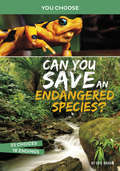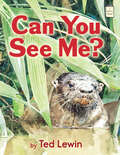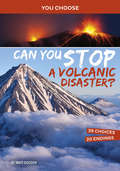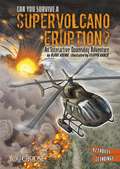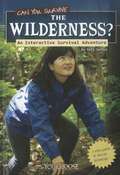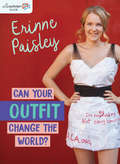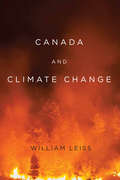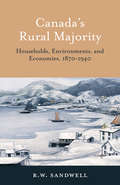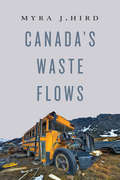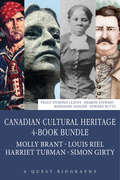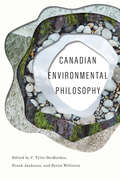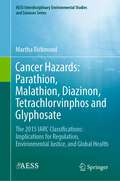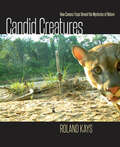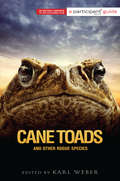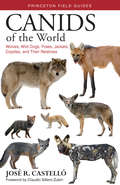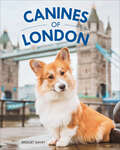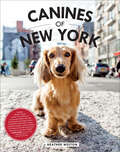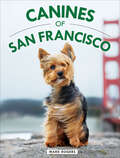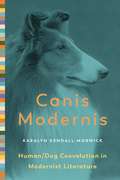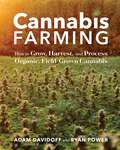- Table View
- List View
Can You Save an Endangered Species?: An Interactive Eco Adventure (You Choose: Eco Expeditions)
by Eric BraunPoachers, habitat destruction, overhunting and fishing, and disease all endanger animal species around the world. But you can help save them! Navigate through three different stories in this mission to save a species. With dozens of possible story outcomes, it's up to you to save the animals from extinction. The planet needs you. Will YOU CHOOSE to help?
Can You See Me? (I Like to Read)
by Ted Lewin"I am a bird. Can you see me?" asks a toucan hidden among the trees. "I am a snake. Can you see me?" challenges a vine snake disguised by its surroundings. In this easy-to-read picture book, Ted Lewin invites readers to explore animal camouflage in the rain forest with a seek-and-find game. Lush watercolor illustrations inspired by Lewin's trips to Costa Rica show how different animals blend into their habitats. The simple text encourages young readers to use their sharp eyes as they try to spot each creature.
Can You Stop a Volcanic Disaster?: An Interactive Eco Adventure (You Choose: Eco Expeditions)
by Matt DoedenThe ground is shaking. A volcano is about the erupt. Hundreds of lives are in danger. But you can help! Navigate through three different stories to discover what is happening below Earth's surface. With dozens of story outcomes, it's up to you to stop a volcanic disaster. The planet needs you. Will YOU CHOOSE to help?
Can You Survive A Supervolcano Eruption?: An Interactive Doomsday Adventure (You Choose: Doomsday Ser.)
by Blake Hoena Filippo VanzoA supervolcano has erupted! Its eruption is thousands of times larger than a normal volcano. Huge amounts of lava and ash threaten all life in the area. You're a visitor to the park when the eruption occurs. Will you stay to monitor the volcano, or evacuate to safety? When YOU CHOOSE what to do next, the choices you make could mean the difference between life and death. Can you survive a supervolcano?
Can You Survive The Wilderness?: An Interactive Survival Adventure (You Choose: Survival Ser.)
by Matt Doeden Chris LaliberteThe wilderness is a place of beauty and peace. But it is also filled with fierce predators, poisonous plants, and raging rivers. Will you: Try to survive the harsh mountains of Alaska after being abandoned during an outdoor training trip? Struggle to make your way out of the deep forests after becoming lost in Australia’s Blue Mountains? Attempt to find help for your injured brother in Washington’s Cascade Mountains?
Can Your Outfit Change the World? (PopActivism)
by Erinne PaisleyWhat you choose to wear becomes part of your identity, but it doesn't affect just you. Your clothing sends a message to the world, whether you want it to or not! And often we don't know what that message really is. Can Your Outfit Change the World? looks at how and where clothes are made, how the people who make the clothes are treated and how the companies who sell the clothes affect the health of our planet. Armed with information, you can follow the book's guide to spending your fashion dollars in a responsible and eco-friendly way. Your outfits have more power than you might realize!
Canada Goose (Nature's Children)
by Judy RossHow fast can a Canada goose fly? What do geese eat? What are baby geese called? Find the answers to these questions, and learn much more about the physical characteristics, behavior, habitat, and lives of Canada geese.
Canada and Climate Change (Canadian Essentials)
by William LeissPandemics, massive earthquakes, war, and other catastrophes inspire immediate action because their casualties and destruction are immediately visible. Climate change is an unyielding problem because its long-range dangers are hidden, and thus it is a global risk unlike anything in human experience.The federal government recently announced aggressive climate targets for Canada. We have committed to producing net-zero greenhouse gas emissions by 2050, which will require major changes for our economy and way of life. Canadian citizens need to understand why our most distinguished climate scientists and our senior political leaders think that we must meet this target. Canada and Climate Change explains the importance of policies that will ensure we meet the net-zero emissions target. William Leiss provides a firm grasp on what climate change is and how scientists have described shifts in the earth’s climate as they have occurred over hundreds of millions of years and as they are likely to occur in the near future, especially by the end of this century.Leiss argues that citizens have a right to place their trust in what climate scientists tell us. Canada and Climate Change is an essential primer on where we stand on the issue of climate change in Canada and what will unfold in the years ahead.
Canada's Rural Majority: Households, Environments, and Economies, 1870-1940
by R. W. SandwellBefore the Second World War, Canada was a rural country. Unlike most industrializing countries, Canada's rural population grew throughout the century after 1871 - even if it declined as a proportion of the total population. Rural Canadians also differed in their lives from rural populations elsewhere. In a country dominated by a harsh northern climate, a short growing season, isolated households and communities, and poor land, they typically relied on three ever-shifting pillars of support: the sale of cash crops, subsistence from the local environment, and wage work off the farm.Canada's Rural Majority is an engaging and accessible history of this distinctive experience, including not only Canada's farmers, but also the hunters, gardeners, fishers, miners, loggers, and cannery workers who lived and worked in rural Canada. Focusing on the household, the environment, and the community, Canada's Rural Majority is a compelling classroom resource and an invaluable overview of this understudied aspect of Canadian history.
Canada's Waste Flows
by Myra J. HirdFrom shipments of Canadian waste rotting in developing countries to overflowing landfills and ineffective recycling programs, Canada is facing a waste crisis. Canadians are becoming increasingly aware that waste is an acute environmental and human health issue – and a complex one, the solutions to which are often contradictory.Canada's Waste Flows is an honest look at the production and movement of Canadian waste, from region to region and across the globe, and its consequences. Through a series of timely empirical case studies, the book reveals waste as less of a technological problem and more of a material, economic, political, historical, and cultural concern. Canada's Waste Flows demonstrates that Canadians are misdirecting their attention to post-consumer waste and their responsibility for minimizing it through recycling; waste must be understood as a social justice issue, and in particular as a symptom of ongoing settler colonialism. Through a comparative study of waste management in southern and northern Canadian communities, Myra Hird argues that we will only resolve our waste crisis through democratic engagement.A critical and compelling book that will generate conversation and incite change, Canada's Waste Flows uncovers how Canada's role as a global leader in waste production and export is key to changing Canada's waste future.
Canadian Cultural Heritage 4-Book Bundle: Molly Brant / Louis Riel / Harriet Tubman / Simon Girty
by Edward Butts Sharon Stewart Peggy Dymond Leavey Rosemary SadlierPresenting four titles in the Quest Biography series profiling prominent figures in Canada’s history. In these four books, we explore the cultural heritage at the roots of Canada’s present-day multicultural society. In the lives of abolitionist Underground Railway hero Harriet Tubman, Metis revolutionary Louis Riel, frontiersman Simon Girty, and aboriginal elder stateswoman Molly Brant, we discover that the struggle for inclusion and human rights has existed since the dawn of Canada’s modern history. Includes: Harriet Tubman Louis Riel Simon GirtyMolly Brant
Canadian Environmental Philosophy
by Byron Williston C. Tyler DesRoches Frank JankunisCanadian Environmental Philosophy is the first collection of essays to take up theoretical and practical issues in environmental philosophy today, from a Canadian perspective. The essays cover various subjects, including ecological nationalism, the legacy of Grey Owl, the meaning of “outside” to Canadians, the paradigm shift from mechanism to ecology in our understanding of nature, the meaning and significance of the Anthropocene, the challenges of biodiversity protection in Canada, the conservation status of crossbred species in the age of climate change, and the moral status of ecosystems. This wide range of topics is as diverse and challenging as the Canadian landscape itself. Given the extent of humanity's current impact on the biosphere – especially evident with anthropogenic climate change and the ongoing mass extinction – it has never been more urgent for us to confront these environmental challenges as Canadian citizens and citizens of the world. Canadian Environmental Philosophy galvanizes this conversation from the perspective of this place.
Canadian Environmental Philosophy
by C. Tyler DesRoches, Frank Jankunis, and Byron WillistonCanadian Environmental Philosophy is the first collection of essays to take up theoretical and practical issues in environmental philosophy today, from a Canadian perspective. The essays cover various subjects, including ecological nationalism, the legacy of Grey Owl, the meaning of “outside” to Canadians, the paradigm shift from mechanism to ecology in our understanding of nature, the meaning and significance of the Anthropocene, the challenges of biodiversity protection in Canada, the conservation status of crossbred species in the age of climate change, and the moral status of ecosystems. This wide range of topics is as diverse and challenging as the Canadian landscape itself. Given the extent of humanity's current impact on the biosphere – especially evident with anthropogenic climate change and the ongoing mass extinction – it has never been more urgent for us to confront these environmental challenges as Canadian citizens and citizens of the world. Canadian Environmental Philosophy galvanizes this conversation from the perspective of this place.
Canadians and the Natural Environment to the Twenty-First Century
by Neil S ForkeyCanadians and the Natural Environment to the Twenty-First Century provides an ideal foundation for undergraduates and general readers on the history of Canada's complex environmental issues. Through clear, easy-to-understand case studies, Neil Forkey integrates the ongoing interplay of humans and the natural world into national, continental, and global contexts.Forkey's engaging survey addresses significant episodes from across the country over the past four hundred years: the classification of Canada's environments by its earliest inhabitants, the relationship between science and sentiment in the Victorian era, the shift towards conservation and preservation of resources in the early twentieth century, and the rise of environmentalism and issues involving First Nations at the end of the century. Canadians and the Natural Environment to the Twenty-First Century provides an accessible synthesis of the most important recent work in the field, making it a truly state-of-the-art contribution to Canadian environmental history.
Cancer Hazards: The 2015 IARC Classifications: Implications for Regulation, Environmental Justice, and Global Health (AESS Interdisciplinary Environmental Studies and Sciences Series)
by Martha RichmondThis book focuses on a monograph published in 2017 by the International Agency for Research on Cancer (IARC), an agency of the World Health Organization (WHO), discussing its carcinogen hazard classification of four pesticides: parathion, malathion, diazinon, and tetrachlorvinphos as well as the herbicide glyphosate. The monograph provided a detailed discussion of considerations and conclusions made by a group of experts who met in 2015 to evaluate these compounds. Although not universally true, many of these substances, from the time of their commercial introduction to their present-day use, have spread significantly in the environment, affecting animals and plants in the larger ecosystem, the overall health of the environment, and human health. This book develops each of these issues before turning to the IARC review process, both the general process and its evolution over time, and compound selection criteria and deliberations regarding the substances discussed in the 2017 monograph. Final book sections detail scientific and private sector reactions to and implications of the IARC classifications. Hazard identification is contrasted with various models of quantitative risk assessment. The last chapters highlight the importance of hazard identification for members of domestic and global underserved communities involved in farming and landscape work, where exposures may vary widely, are not well-regulated, and where health outcomes are often not carefully documented.
Candid Creatures: How Camera Traps Reveal the Mysteries of Nature
by Roland KaysA riveting collection of photographs that captures wild animals in their native habitats.In Candid Creatures, the first major book to reveal the secret lives of animals through motion-sensitive game cameras, biologist Roland Kays has assembled over 600 remarkable photographs. Drawing from archives of millions of color and night-vision photographs collected by hundreds of researchers, Kays has selected images that show the unique perspectives of wildlife from throughout the world. Using these photos, he tells the stories of scientific discoveries that camera traps have enabled, such as living proof of species thought to have been extinct and details of predator-prey interactions.Each image captures a moment frozen in the camera’s flash as animals move through their wild habitats. Kays also discusses how scientists use camera traps to address conservation issues, creating solutions that allow humans and wild animals to coexist. More than just a collection of amazing animal pictures, the book’s text, maps, and illustrations work together to describe the latest findings in the fast-moving field of wildlife research. Candid Creatures is a testament to how the explosion of game cameras around the world has revolutionized the study of animal ecology. The powerful combination of pictures and stories of discovery will fascinate anyone interested in science, nature, wildlife biology, or photography.
Candid Creatures: How Camera Traps Reveal the Mysteries of Nature
by Roland KaysA riveting collection of photographs capturing wild animals in their native habitats and demonstrating the importance of camera traps.In Candid Creatures, the first major book to reveal the secret lives of animals through motion-sensitive game cameras, biologist Roland Kays has assembled over 600remarkable photographs. Drawing from archives of millions of color and night-vision photographs collected by hundreds of researchers, Kays has selected images that show the unique perspectives of wildlife from throughout the world. Using these photos, he tells the stories of scientific discoveries that camera traps have enabled, such as living proof of species thought to have been extinct and details of predator-prey interactions.Each image captures a moment frozen in the camera’s flash as animals move through their wild habitats. Kays also discusses how scientists use camera traps to address conservation issues, creating solutions that allow humans and wild animals to coexist. More than just a collection of amazing animal pictures, the book’s text, maps, and illustrations work together to describe the latest findings in the fast-moving field of wildlife research.Candid Creatures is a testament to how the explosion of game cameras around the world has revolutionized the study of animal ecology. The powerful combination of pictures and stories of discovery will fascinate anyone interested in science, nature, wildlife biology, or photography.“Full of fabulous pictures of weird and wonderful creatures . . . [Candid Creatures is] loaded with information and carries a strong conservation message.” —Conservation Biology
Cane Toads and Other Rogue Species: Participant Second Book Project
by Participant Productions edited by Karl WeberWhat does an unusually large, ugly, invasive species of toad have to do with global warming, international trade, and the survival of biodiversity? Quite a lot, actually. Mark Lewis's amazing and hilarious documentary Cane Toads tells the story of Bufo marinus, which was introduced to Australia in 1935 to control bugs but which quickly became a far greater menace than the beetles they eat. Today they number in the hundreds of millions and are taking over Australian habitats at 25 miles per year, spreading disease and killing native species as they go. Rogue Species explains the little-understood dangers of invasive species. Ranging from the zebra mussel (currently threatening the health of the Great Lakes) to the infamous kudzu vine (a Japanese import that now smothers seven million acres in the American southeast), these disastrous human blunders threaten the biodiversity on which all life-including our own-depends. The book will raise readers' awareness about the threat of non-native species, increase their appreciation of natural biodiversity, and explain what they can do to help protect unique ecosystems wherever they live or travel.
Canids of the World: Wolves, Wild Dogs, Foxes, Jackals, Coyotes, and Their Relatives (Princeton Field Guides)
by José R. Castelló Claudio Sillero-ZubiriThe most complete and user-friendly photographic field guide to the world’s canids <P><P>This stunningly illustrated and easy-to-use field guide covers every species of the world’s canids, from the Gray Wolf of North America to the dholes of Asia, from African jackals to the South American Bush Dog. <P><P> It features more than 150 superb color plates depicting every kind of canid and detailed facing-page species accounts that describe key identification features, morphology, distribution, subspeciation, habitat, and conservation status in the wild. The book also includes distribution maps and tips on where to observe each species, making Canids of the World the most comprehensive and user-friendly guide to these intriguing and spectacular mammals.Covers every species and subspecies of canid <br>Features more than 150 color plates with more than 600 photos from around the globe <br>Depicts species in similar poses for quick and easy comparisons <br>Describes key identification features, habitat, behavior, reproduction, and much more <br>Draws on the latest taxonomic research <br>Includes distribution maps and tips on where to observe each species <br>The ideal field companion and a delight for armchair naturalists
Canines of London
by Bridget DaveyA joyful celebration of London’s vibrant dog community, Canines of London collects close to 300 engaging photos taken throughout neighborhoods and parks within this eclectic, dog-loving city. From English Bulldogs to Welsh Corgis, Golden Retrievers to Dachshunds, London is full of dogs and the people who love them. In Canines of London, dog photographer Bridget Davey gathers up close to 300 photos taken all around one of world's great dog-loving cities. Gaze upon delightful pups living large beside Buckingham Palace, the London Eye, Piccadilly Circus, and more. No London landmark is left unvisited, and no dog left unphotographed. The follow up to Weldon Owen’s Canines of New York and Canines of San Francisco, this is the perfect gift for dog lovers everywhere. DIVERSE BREEDS AND ICONIC LOCATIONS: Includes over 300 utterly delightful photographs of dogs out and about in London, from Big Ben to the London Eye to the local pub, plus captions that give cute details of each dog's personality. Sure to delight dog lovers everywhere. PERFECT FOR ANGLOPHILES: London is a world-class city beloved by those both in and out of the UK. it's also the most popular tourist destination in the world, attracting over 30 million international visitors every year. LATEST IN A SUCCESSFUL SERIES: Weldon Owen’s Canines of New York and Canines of San Francisco have pleased dog lovers across the world, and London is sure to be the most amazing dog destination yet.
Canines of New York (Canines Ser.)
by Heather WestonHundreds of photographs that “capture the essence and the heart of these wonderful creatures in glorious settings” (Julie Klam, New York Times-bestselling author).A visual celebration, Canines of New York collects more than three-hundred photographs taken by acclaimed Brooklyn-based photographer Heather Weston throughout the five boroughs of this incredible, dog-loving city. Featuring pups in every part of the Big Apple, from iconic landmarks to their owners’ brownstone steps, this is the perfect gift for every dog lover.“Weston’s love of both dogs and New York City shines in every funny, gorgeous photograph. She captures the special brightness dogs bring to big-city life, from the Bronx to the Battery and in every borough.” —E. Lockhart, #1 New York Times-bestselling author of We Were Liars“Whether it’s a Brooklyn pupster, a Bronx Bulldog, a canine commuter on the Staten Island Ferry or a group of buddies meeting at a Soho dog park, photographer Heather Weston perfectly captures what it means to be a dog in the City That Never Sleeps.” —Dogster“The perfect book to showcase some of New York City’s furry friends . . . displays practical, pompous, and pretty pooches like never before.” —Broadway World
Canines of San Francisco
by Mark RogersA joyful celebration of the canine community throughout every neighborhood in this passionate, dog-loving city from the acclaimed Bay Area photographer. In this book featuring some 300 photographs of the dogs that call The City by the Bay their home, acclaimed Bay Area and dog rescue photographer Mark Rogers has a unique talent for capturing each dog’s individual personality, as tiny puppies dominate even the most iconic landmarks. From the Golden Gate Bridge to Haight-Ashbury, from Alcatraz to the Embarcadero, this book is an adorable tribute to the city’s most fetching four-legged inhabitants.
Canis Modernis: Human/Dog Coevolution in Modernist Literature (Animalibus)
by Karalyn Kendall-MorwickModernist literature might well be accused of going to the dogs. From the strays wandering the streets of Dublin in James Joyce’s Ulysses to the highbred canine subject of Virginia Woolf’s Flush, dogs populate a range of modernist texts. In many ways, the dog in the late nineteenth and early twentieth centuries became a potent symbol of the modern condition—facing, like the human species, the problem of adapting to modernizing forces that relentlessly outpaced it. Yet the dog in literary modernism does not function as a stand-in for the human. In this book, Karalyn Kendall-Morwick examines the human-dog relationship in modernist works by Virginia Woolf, Jack London, Albert Payson Terhune, J. R. Ackerley, and Samuel Beckett, among others. Drawing from the evolutionary theories of Charles Darwin and the scientific, literary, and philosophical work of Donna Haraway, Temple Grandin, and Carrie Rohman, she makes a case for the dog as a coevolutionary and coadapting partner of humans. As our coevolutionary partners, dogs destabilize the human: not the autonomous, self-transparent subject of Western humanism, the human is instead contingent, shaped by its material interactions with other species. By demonstrating how modernist representations of dogs ultimately mongrelize the human, this book reveals dogs’ status both as instigators of the crisis of the modern subject and as partners uniquely positioned to help humans adapt to the turbulent forces of modernization.Accessibly written and convincingly argued, this study shows how dogs challenge the autonomy of the human subject and the humanistic underpinnings of traditional literary forms. It will find favor with students and scholars of modernist literature and animal studies.
Canis Modernis: Human/Dog Coevolution in Modernist Literature (Animalibus: Of Animals and Cultures #19)
by Karalyn Kendall-MorwickModernist literature might well be accused of going to the dogs. From the strays wandering the streets of Dublin in James Joyce’s Ulysses to the highbred canine subject of Virginia Woolf’s Flush, dogs populate a range of modernist texts. In many ways, the dog in the late nineteenth and early twentieth centuries became a potent symbol of the modern condition—facing, like the human species, the problem of adapting to modernizing forces that relentlessly outpaced it. Yet the dog in literary modernism does not function as a stand-in for the human. In this book, Karalyn Kendall-Morwick examines the human-dog relationship in modernist works by Virginia Woolf, Jack London, Albert Payson Terhune, J. R. Ackerley, and Samuel Beckett, among others. Drawing from the evolutionary theories of Charles Darwin and the scientific, literary, and philosophical work of Donna Haraway, Temple Grandin, and Carrie Rohman, she makes a case for the dog as a coevolutionary and coadapting partner of humans. As our coevolutionary partners, dogs destabilize the human: not the autonomous, self-transparent subject of Western humanism, the human is instead contingent, shaped by its material interactions with other species. By demonstrating how modernist representations of dogs ultimately mongrelize the human, this book reveals dogs’ status both as instigators of the crisis of the modern subject and as partners uniquely positioned to help humans adapt to the turbulent forces of modernization.Accessibly written and convincingly argued, this study shows how dogs challenge the autonomy of the human subject and the humanistic underpinnings of traditional literary forms. It will find favor with students and scholars of modernist literature and animal studies.
Cannabis Farming: How to Grow, Harvest, and Process Organic, Field-Grown Cannabis
by Adam Davidoff Ryan PowerStart your own organic cannabis farm with this complete how-to manual written by two farmers with a decade of experience growing cannabis in the field. Cannabis is rapidly being decriminalized across the country, causing a surge in consumer demand and enabling growers to cultivate cannabis in the open, rather than secretly in greenhouses. Whether you&’re a small-scale vegetable farmer who wants to add a high-value crop or a home cannabis grower who wants to expand their operation, authors Adam Davidoff and Ryan Power can help you get growing. They were some of the first vegetable farmers in California to start growing cannabis as a field crop, and have even developed their own cannabis strains that are adapted to field growing rather than indoor cultivation. Now is the perfect time to start growing cannabis for profit!
